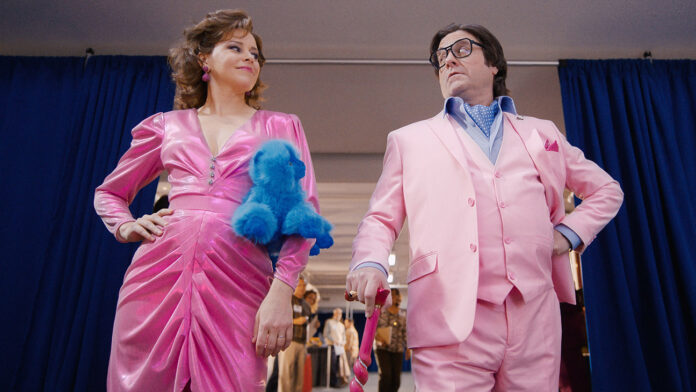This past weekend’s big noise at the movies, in case you’ve miraculously missed all hype, was the so-called “Barbenheimer,” pitting Mattel Co. against Manhattan Project, Greta Gerwig’s Barbie vs. Christopher Nolan’s Oppenheimer. We won’t add to the din by lingering on either much further—both were going to be adored by many, and “meh’d” by people who’ll mostly keep that opinion to themselves. I did not love either of them (and in fact left one midway), but can understand why that will be a minority view, possibly even a heretical one, amongst their separate target audiences. There is certainly one undeniable upside to their arrival: At least Tom Cruise has suffered a demotion at the box office, however temporary.
If you’re still curious about either behemoth, but perhaps not brave enough yet to face the mammoth crowds, there are relevant alternatives. One is the 25th anniversary re-release of Susan Stern’s 1998 Barbie Nation: An Unauthorized Tour. This hour-long documentary (offered in a slightly longer “director’s cut”) roams the globe to weigh the impact of the Plastic One’s decades on this planet—of course it may take centuries yet for her to biodegrade. That encompasses much input from late Mattel co-founder Ruth Handler, who invented Barbie in part to normalize physical development for girls who at the time only had “baby dolls” to play with. But Barbie was a woman, with breasts (if not a lot else), thus providing a sort of educational role model… however complicated that status became later on.
Stern (who more recently made the excellent Bad Attitude: The Art of Spain Rodriguez) visits a Mattel convention in Orlando, the no-longer-extant Barbie Museum in Palo Alto, a dedicated art show in which Barbies are depicted doing things that would surely displease their litigious corporate rights holders, drag homages at the SF Gay Day Parade, and so forth. Given that this breezy survey was assembled before the Internet and eBay hit anywhere near peak velocity, one can only imagine just how much bigger the world of Barbie collectors has grown since. Nation was released last month to major On Demand platforms; more info is available here.
For a while there, that skinny sylph was knocked out of contention by another phenomenon of adults hoarding the many variations of a child’s toy, which duly began being manufactured precisely to egg on their mania for “collectibles.” The Beanie Bubble is a dramatization of a nonfiction tome I clearly have to read, since it is titled The Great Beanie Baby Bubble: Mass Delusion and the Dark Side of Cute.
This directorial feature debut for Kristin Gore (yes, Al and Tipper’s kid) and Damian Kulash of indie pop band OK Go is a fairly starry affair, with Zach Galfianakis, Elizabeth Banks, and Sarah Snook depicting fictionalized figures in the Beanie Baby craze. That was considered the “first Internet sensation,” inducing a cryptocurrency-like run on dolls whose supposed scarcity were said to translate into eventual huge resale values. You know how such things end: As landfill, with a whole lotta folks disillusioned en route concerning their supposed retirement windfall. The Beanie Bubble is currently playing in limited theaters and becomes available for streaming on Apple TV+ July 28.
One of the wittier ideas in Gerwig’s Barbie is that Margot Robbie’s titular character creates a rip in the time-space continuum between Barbieland and the real world when her usual sunny optimism becomes unexpectedly shaded by thoughts of… death. In that respect, at least, she shares more than just an opening weekend with J. Robert Oppenheimer.
He hoped the realization of weapons of mass destruction like the A-bomb he helped shepherd into being would cap humanity’s warring nature, since now one could go from zero to apocalypse with the press of a button. Yet The Bomb’s existence only escalated a post-WW2 arms race, rather than inducing cautionary de-escalation.
And the threat of nuclear holocaust has hardly stopped regional conflicts, civil wars, genocidal campaigns, and foreign invasions from breaking out in the decades since. The Sundance-premiered 20 Days in Mariupol, provides an up-to-the-moment reminder that the underlying humanitarian issues in Nolan’s film are still being played out every day around the globe.
Mstyslav Chernov’s film (read 48 Hills’ interview with the director-journalist here) is a portrait of the titular Ukrainian city under siege from during the three weeks from the first shelling by Russian forces to the point where he and his Associated Press crew were forced to flee. These events in early 2022 were accompanied by Putin’s claims that this “Special Military Operation” undertaken in “self-defense” (as if Ukraine were the aggressor) was of course not targeting residential areas or emergency facilities—even as we watch entire hospitals, apartment highrises, et al. reduced to rubble. Infrastructure is systematically destroyed, until there’s little point in journalists staying, as they can’t get their stories out anyway.
This you-are-there footage is painful to watch (as the director duly notes), and its impact is not alleviated by the interspersing of breaking international news coverage—some of it utilizing clips we’ve just seen in their raw form. While Chernov allows himself no personal hand-wringing or political analysis, the fury and distress of the locals abruptly rendered homeless refugees is palpable.
“What did we do to deserve this?,” one mother asks, and of course the answer is “nothing.” They are victims of a hostile conquest, pure and simple. Mercifully, even as the war in Ukraine drags on, the sixteen months or so since have seen Russia’s hopes of a quick triumph steadily crumble. It is just possible now that this whole unnecessary conflict may prove Putin’s Waterloo. But Mariupol did fall to its invaders, and this bleak but riveting document provides an indelible record of the human cost to realizing the power-mad dreams of warlords.
20 Days at Mariupol is currently playing at the Roxie, check the schedule here.






